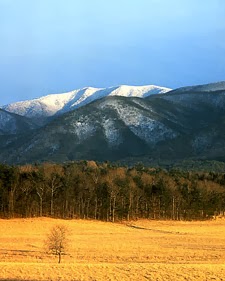 |
| Photo: Brian Stansberry / Creative Commons |
Great Smoky Mountains National Park maintains the cove to
look like the early settler days. Rustic log cabins dot the landscape, which
has been devoid of residents for about 70 years.
But there was a good deal more hustle and bustle in 1860: 700 residents farmed and conducted business
with the nearby communities of Maryville and Knoxville. They built clapboard homes
and largely prospered.
“It was not considered to be so isolated by the standard of
the 1860s,” said Aaron Astor, associate professor of history at Maryville College, a small liberal arts
institution.
But four years of brother against brother changed that.
 |
| Aaron Astor |
“The Civil War really soured the residents and they turned
inward,” said Astor, who is helping to lead a Great Smoky Mountains Civil War tour this Friday and Saturday (Dec. 13-14), with
several stops in Cades Cove.
“Cades Cove was mostly a mix of ambivalence of just wanting to stay out
of the war and support for the Union,” said Astor. Throw in a smattering of
abolitionists and pro-Southerners, and you have a recipe for nasty conflict.
Most residents were pro-Union, while some prominent citizens, businessman
Daniel Foute among them, backed the Confederacy.
In Eastern Tennessee, communities connected by railroad to Georgia or
Virginia were more connected to the Southern cause, Astor told the Picket.
Knoxville, which eventually fell to Federal forces, had split
allegiances.
“When we talk about loyalties in the Civil War, we have to realize they
are not always a steadfast thing,” said the historian, who has written several
articles for The New York Times Civil War blog, Disunion.
“A lot of people’s loyalties can shift around…. People had to do what
they had to do to survive,” said Astor.
Among his areas of interest are the war’s border regions, where
sentiments for both sides simmered and bloody guerrilla warfare and raids are
widespread. Astor’s 2012 book on the subject is entitled, “Rebels on the
Border: Civil War, Emancipation, and the Reconstruction of Kentucky and Missouri.”
 |
| (NPS photo) |
“Cades Cove did not have large battles,” according to Astor. “But it was considered a perfect raiding ground, particularly by Confederates, to take all kinds of livestock and grain.”
The people of Cades Code formed home guards to protect their property and
livelihoods from raiders.
“There would be children who would blow horns or make certain sounds to indicate that raiders were coming,” said Astor.
The first stop in Saturday’s tour – sponsored by the Tennessee Civil War Preservation Association -- will be just outside the park, in the
community now called Walland.
The so-called “flagpole incident” occurred when Confederate troops and
recruiters were warned to leave a U.S. flag alone – or else.
“They were not exactly welcomed into this heavily unionist section of the
mountains,” said Astor. “They were able to get in there and out alive.”
The flag remained flying.
 |
| Primitive Baptist Church (Brian Stansberry / Creative Commons) |
For many, questions of allegiance evolved as the war ground on.
With little fertile land, Cades Code had virtually no slaves when war broke out. Those belonging to Foute, whose homestead will be visited Saturday, toiled elsewhere in Blount County.
“There is a huge segment of the upper South that are conservative
unionists who believed the Union was the best protector of slavery,” said Astor.
They feared a war would break down the social structure.
By late 1862 and early 1863, with the announcement of the Emancipation
Proclamation, the war is perceived to be largely about ending slavery.
Federal forces secured control of Knoxville in 1863.
Pro-Union newspaper editor William Gannaway Brownlow, who was to become
Tennessee governor after the war, called fence sitters traitors.
Before and after Knoxville fell, Confederates harassed and attacked those
with Union sympathies. Many fled to Kentucky,
with hopes of one day returning.
“Confederates are seeing them as disloyal to the South,” said Astor. “It
is open season to move in.”
 |
| View of Fort Sanders (Library of Congress) |
During the Fort Sanders campaign, “Both armies are just trying to take food and they do not carry who is loyal to who.”
The tour will include the homestead and gravesite of Russell Gregory, who
was killed in a Confederate reprisal attack in 1864. His son, Charles, was in
the unit that returned to the valley and killed Gregory.
By then, war-weary Cades Cove inhabitants had less protection and support
after federal commanders had taken the war to Georgia.
“There is a feel of abandonment
and distrust of all outsiders,” said Astor.
Other anticipated stops Saturday are the Cades Cove ranger station, Cable
Cemetery and the Primitive Baptist,
Methodist and Missionary Baptist churches.
Astor hopes participants will come away with a deeper knowledge about
what happens in a no man’s land, caught between North and South.
“This is a mountain version of a community caught in between a war nobody
in there wanted. It is a story of survival, a community having to rely on its
own internal resources.”
-- Click here for more information on the tour. Registration
is required because of limited spots. Another tour will be done in April,
according to Astor. You can reach the professor at (801) 349-8889 or aaron.astor@maryvillecollege.edu.
No comments:
Post a Comment